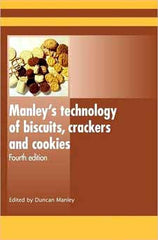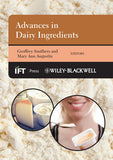Manley's Technology of Biscuits, Crackers and Cookies Fourth edition by Duncan Manley
Fourth edition
by Duncan Manley
Manley's Technology of Biscuits, Crackers and Cookies is a major reference handbook for the cookie and cracker industry. This brand new updated and enlarged edition is a must for the manufacturer and bakery technologist.
Covering every facet of the industry from management to manufacturing, this major handbook, now in its fourth edition, is a practical guide that can be utilized by anyone in the industry.
Eleven years has passed since the publication of the third edition, and in that time the pace of change witnessed by the industry more than justifies this fully updated and revised edition.
Features:
Part One covers management issues such as HACCP, quality control, process control and product development.
Part Two deals with the selection of raw materials and ingredients.
Part Three covers the range and types of biscuits.
Part Four covers the main production processes and equipment, from bulk handling and metering of ingredients to packaging, storage and waste management.
CONTENTS
Part 1: Management of Technology in Biscuit Manufacture
The role of the technical department in biscuit manufacture
- The requirements of the technical (or technology) department
- Selection of staff for the technical department
- Facilities for the technical department
- Liaison with other technical establishments
- Support for purchasing
- Support for training
- Management of technical developments
Quality management systems and (HACCP) in biscuit manufacture
- Quality management
- Management of product safety
Quality control and good manufacturing practice (GMP) in the biscuit industry
- Principles and management
- Quality control tasks for finished product inspection
- Quality control tasks for ingredient and packaging materials
- Good manufacturing practice (GMP)
- Hygiene surveys
Process and efficiency control in biscuit manufacture
- Process control and efficiency
- Process audit
- Process control checks and records for plants with no continuous monitoring sensors
- Making process control measurements
- Action procedures as a result of product measurements
- Instrumentation for monitoring
- Efficiency and integrated plant control
- Outline of the instrumentation that is available - Troubleshooting
- Energy efficiency
Product development in the biscuit industry
- Product development
- Facilities for process and product development
- Assessing products
- Establishing the product specification
Sustainability in the biscuit industry
- Key drivers for sustainability in the biscuit industry
- Carbon emissions and energy use
- Reducing water use
- Reducing waste
- Packaging
- Other options for improving sustainability
Part 2: Materials and Ingredients for Biscuit Manufacture
Choosing materials for biscuit production
- Important technical aspects
- Important commercial aspects
- Programme for the meeting with a supplier
Wheat flour and vital wheat gluten as biscuit ingredients
- Flour from the viewpoint of the miller
- Flour from the viewpoint of the biscuit manufacturer
- Vital wheat gluten
Meals, grits, flours and starches (other than wheat)
- Cereal based materials
- Non-cereal flours and starches
Sugars and syrups as biscuit ingredients
- Common sugar, sucrose
- Syrups
- Sugars and syrups from starches - glucose
- Non-diastatic malt extract
- Maillard reaction
- Polyols
Fats and oils as biscuit ingredients
- The role of fat in biscuits
- The chemistry and physical properties of fats
- Quality and handling issues of fats
- Key characteristics of fats for biscuits
- Quality control of fats
- General specification requirements for oils and fats
- Challenges for the biscuit manufacturer
Emulsifiers (surfactants) and antioxidants as biscuit ingredients
- Function of emulsifiers in biscuits
- Types of food emulsifiers
- Reduced fat biscuits
- General use of emulsifiers in biscuit doughs
- Application help
- Anti-oxidants
Milk products and egg as biscuit ingredients
- Milk and milk products
- Egg
Dried fruits and nuts as biscuit ingredients
- Dried grapes
- Other dried fruits used in biscuits
- Fruit pastes and syrups
- Tree nuts
- Peanuts, arachis or ground nut
- Health problems associated with nuts
Yeast and enzymes as biscuit ingredients
- Yeast
- Enzymes
Flavours, spices and flavour enhancers as biscuit ingredients
- Sources and types of flavours
- Suitability of a flavour material
- Flavouring of biscuits
- Flavour enhancers
- Storage of flavours and quality control
Additives as biscuit ingredients
- Common salt (sodium chloride, NaCl)
- Leavening agents
- Processing aids
- Food acids
- Colours
- Artificial sweeteners
Chocolate and cocoa as biscuit ingredients
- The flavour of chocolate
- Chocolate viscosity
- Cocoa butter, cocoa butter equivalents and hard butters
- Definitions of cocoa and chocolate products
- Types of chocolate
- Supply and storage of chocolate
- Chocolate drops and chips
- Cocoa
- Handling of chocolate and chocolate chips
- Compound chocolate
- Carob powder
Packaging materials for biscuits and their influence on shelf life
- Packaging materials
- Packaging and shelf life
- Indices of failure (IoFs)
- Package requirements to address (IoFs)
Classification of biscuits
- Classification based on enrichment of the formulation
- Conversion of units
Cream crackers
- History and introduction to cream crackers
- Mixing and fermentation of cream cracker doughs
- Dough piece forming
- Baking of cream crackers
- Yields from fermented doughs
Soda crackers
- Dough preparation
- Outline of typical soda cracker manufacturing techniques
Savoury or snack crackers
- General description
- Manufacturing technology
- Post-oven oil spraying
Matzos and water biscuits
- Matzos
- Water biscuits
- Typical recipes
Puff biscuits
- General description
- Puff dough preparation
- Baking of puff biscuits
- Puff biscuit production techniques
Hard sweet, semi-sweet and Garibaldi fruit sandwich biscuits
- General description of this group of biscuits
- Ingredients and recipes
- Dough mixing
- Mixer instrumentation
- Dough piece forming
- Instrumentation of the forming machine
- Baking
- Flavouring of biscuits
- Cooling and handling of biscuits
- Continental semi-sweet biscuits
- Garibaldi or fruit sandwich biscuits
Short dough biscuits
- Description of the group
- Recipes and ingredients
- Dough mixing
- Dough piece forming
- Instrumentation of the forming machine
- Baking
- Factors affecting dough piece spread during baking
Deposited soft dough and sponge drop biscuits
- Description of deposited biscuits
- Description of sponge batter drops
- Typical recipes
Wafer biscuits
- The wafer oven or wafer baker
- Wafer sheet production
- Batter mixing
- Batter handling
- Batter deposition and baking
- Sheet handling, creaming and cutting
- Process control of wafer production
- Hollow rolled wafer sticks
The position of biscuits in nutrition
- Biscuits in our diets
- The evolution of biscuit nutrition
- Different biscuits for different people
- Food labelling can help – only when you understand it
Miscellaneous biscuit-like products
- Products that are made on a type of biscuit plant
- Products that are not made on conventional biscuit plant
Part 4: Biscuit Production Processes and Equipment
Bulk handling and metering of biscuit ingredients
- Bulk handling
- Some technical aspects of bulk handling
- Process control in bulk storage
- Metering of ingredients to mixers
Mixing and premixes in biscuit manufacture
- General conditions for mixing
- Process control and instrumentation of mixers
- Considerations in the selection of a mixer
- Types of mixer available for biscuit doughs
- Integrated mixing schemes in the future
- Premixes
Sheeting, gauging and cutting in biscuit manufacture
- Principles
- Sheeters
- Gauge rolls
- Multiple roller gauging units
- Dough relaxation units
- Cutting
- Cutter scrap dough handling
- Dough piece garnishing and panning
- Control of biscuit cutting machines
- Operator maintenance requirements
Laminating in biscuit manufacture
- Principles and techniques of laminating
- Types of automatic laminator
- Is laminating really necessary?
- Process control during laminating
Rotary moulding in biscuit manufacture
- General description of the rotary moulding machine
- The formation of the dough piece
- Dough piece weight control
- Differential speeds of moulding roller and extraction roller
- Common difficulties that may be encountered with rotary moulders
- Instrumentation of a rotary moulder
- Disadvantages of a rotary moulder
- The soft dough rotary moulder and roto depositor
- Printing on dough pieces
Extruding and depositing of biscuit dough
- General description of extruding and depositing machines for doughs
- Process control of extruded and deposited biscuits
- Sponge batter drops and lady finger biscuits
Biscuit baking
- Changes to the dough piece during baking
- Oven conditions
- Typical baking profiles
- Types of oven
- Preparation and care of oven bands
- Measurement and control in baking
- Post oven oil spraying
Biscuit cooling and handling
- Checking
- Methods and speeds of cooling
- Biscuit handling prior to packaging
Secondary processing of biscuits
- General considerations
- Sandwich creams
- Icing
- Jams, jellies, caramels and marshmallows
- Chocolate and chocolate flavoured coatings
Biscuit packaging and storage
- Functions of a pack
- Types of primary packages
- Collation and feeding to wrapping machines
- Biscuit size variations
- Post wrapping operations
- Process and quality control
- Storage
- Robotics
- Useful reading and address
Recycling, handling and disposal of waste biscuit materials
- Management of waste
- Sources of waste materials
- Estimating the size of the problem
- Recycling
- Disposal of waste materials which are not recycled
Index


















